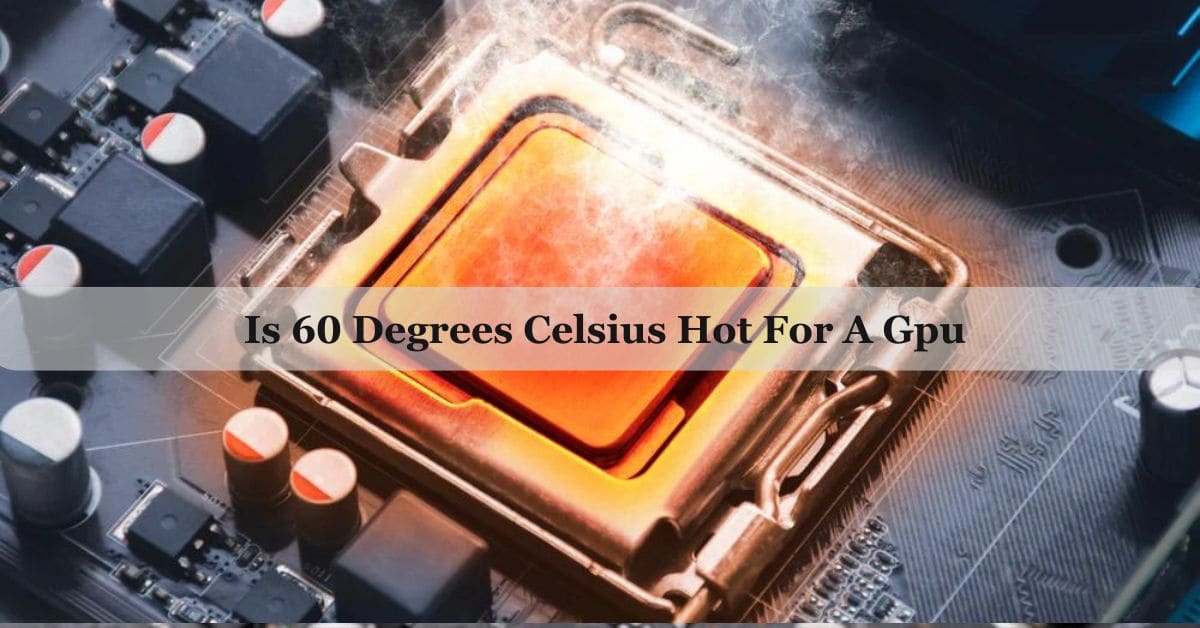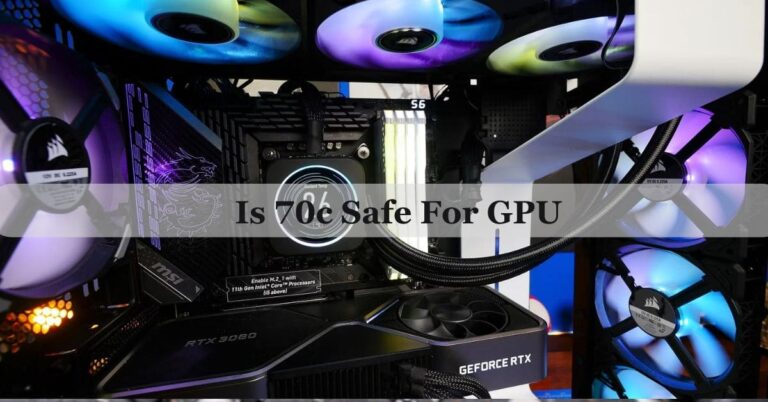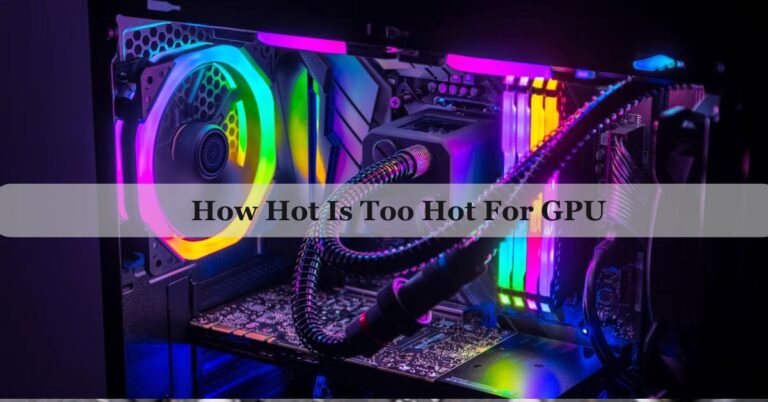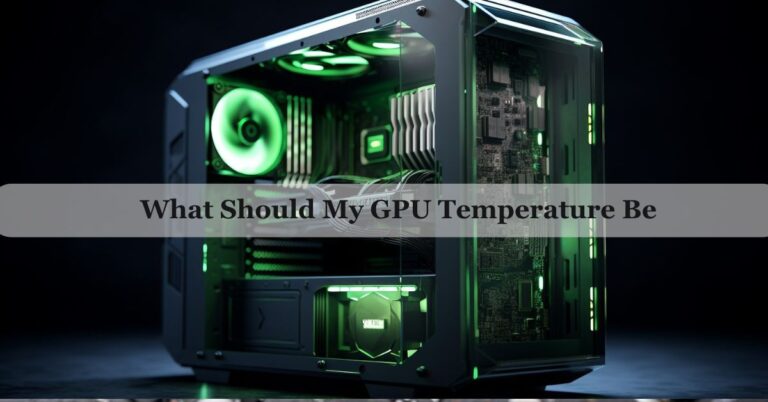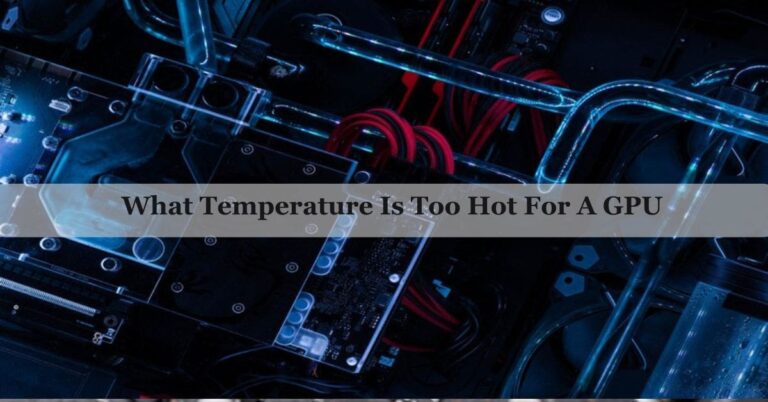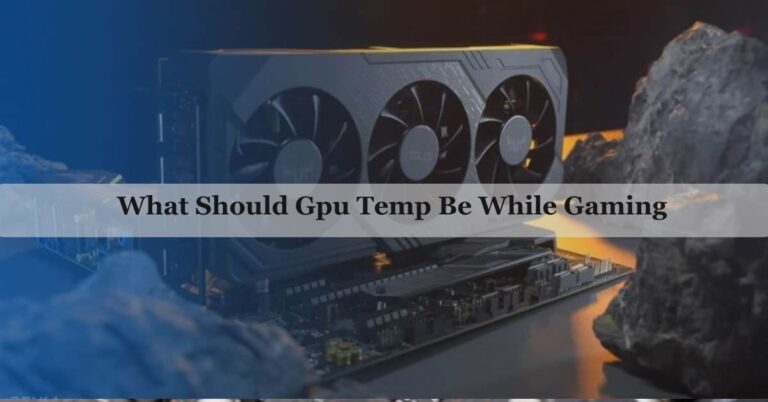Is 60 Degrees Celsius Hot For A GPU – Safe GPU Temperature!
“I wondered, ‘Is 60 degrees Celsius hot for a GPU?’ but found out it’s perfectly safe and a sign that my GPU is running efficiently. It gave me peace of mind while playing my favorite games!”
Is 60 Degrees Celsius Hot for a GPU? No, 60 degrees Celsius is not hot for a GPU. It is a normal and safe temperature, especially during demanding tasks like gaming or rendering. Most GPUs are designed to handle temperatures up to 85-95°C, making 60°C well within the safe range.
Is 60 degrees Celsius hot for a GPU? Find out in our latest article! We cover why this temperature is normal, how it affects performance, and tips for keeping your GPU in top shape. Check it out now!
What Is A Gpu?
A GPU, or Graphics Processing Unit, is a part of your computer that helps create images, videos, and animations. It’s important for gaming, video editing, and other tasks that need lots of graphical power.
How Can I Check My Gpu Temperature?
To check your GPU temperature, you can use simple software tools. Download and install a program like MSI Afterburner or HWMonitor. Open the program, and you’ll see a section showing the temperature of your GPU.
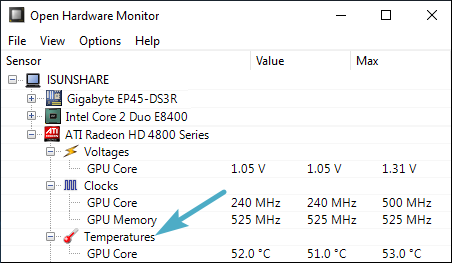
For MSI Afterburner, look at the “Core Temp” reading. For HWMonitor, find the “GPU” section and check the temperature listed there. This way, you can easily monitor how hot your GPU is getting while you use your computer.
What Should I Do If My GPU Temperature Goes Above 60 Degrees Celsius?
If your GPU temperature goes above 60 degrees Celsius, there are a few steps you can take to cool it down. First, check if your fans are working properly and clean any dust from your PC. Next, improve airflow by organizing cables and making sure your case has good intake and exhaust fans.
You might also want to upgrade your GPU cooler or add extra case fans for better cooling. If these steps don’t help, consider reapplying thermal paste to the GPU or seeking professional help to ensure your GPU stays cool.
Is 60 Degrees Celsius Hot For A GPU?
No, 60 degrees Celsius is not hot for a GPU. In fact, it is a normal and safe temperature, especially when your GPU is working hard, like during gaming or video editing.
GPUs are designed to handle temperatures up to 85-95 degrees Celsius, so 60°C is well within the safe range for good performance and long-term health of your graphics card.
61 Degrees Celsius Hot For A GPU:
No, 61 degrees Celsius is not hot for a GPU. It’s a safe and normal temperature, especially if your GPU is under heavy use, like gaming or rendering. Most GPUs are designed to handle temperatures up to 85-95 degrees Celsius. As long as your GPU stays below this range, 61°C is perfectly fine for performance and longevity.
64 Degrees Celsius Hot For A GPU:
64 degrees Celsius is not hot for a GPU either. It is within the safe operating range, even for demanding tasks. GPUs are built to manage temperatures up to around 85-95 degrees Celsius, so 64°C is a normal and manageable temperature for your graphics card.
Also Read: Runtimeerror: No Gpu Found. A Gpu Is Needed For Quantization. – Here’s How to Fix It!
What Is A Safe Temperature For A GPU?
A safe temperature for your GPU ensures it performs well and lasts a long time. Here’s what you need to know:
Idle Temperature:
When your computer is not doing much work, a safe GPU temperature is 30 to 50 degrees Celsius. This is when you are just browsing the web or checking emails.
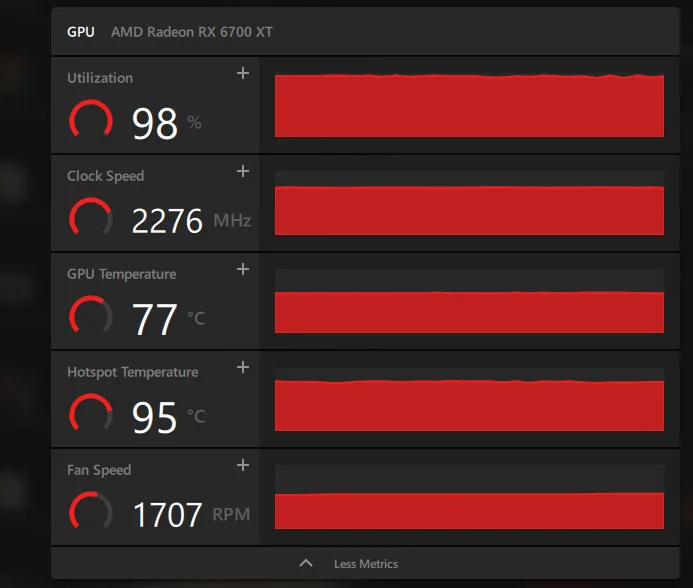
Load Temperature:
During demanding tasks like gaming or video editing, a safe temperature is 60 to 85 degrees Celsius. This range is normal for a GPU working hard.
High-Performance GPUs:
Some high-end GPUs can handle temperatures up to 90-95 degrees Celsius under heavy load, but it’s still best to keep temperatures as low as possible for better performance and longevity.
Cooling Solutions:
To keep your GPU within these safe ranges, make sure you have good cooling solutions like proper case ventilation, clean fans, and high-quality thermal paste.
Check Regularly:
Use software tools like MSI Afterburner or HWMonitor to keep an eye on your GPU temperatures and ensure they stay within these safe limits.
Why Does My GPU Get Hot Quickly?
Your GPU can get hot quickly for several reasons. If you’re running demanding tasks like gaming or video editing, the GPU works harder and generates more heat. Poor airflow in your computer case, such as blocked fans or dust buildup, can also trap heat.
Old or dried-out thermal paste between the GPU and cooler can reduce cooling efficiency. Make sure your fans and heatsinks are clean, and check for good airflow and thermal paste to keep your GPU cool.
What Is Idle And Load Temperature?
Idle Temperature:
Idle Temperature is the temperature of your GPU when it’s not doing much work. This happens when you’re just using basic programs like web browsers or word processors. During idle time, your GPU is relaxed and the temperature is usually between 30 and 50 degrees Celsius.
Load Temperature:
Load Temperature is the temperature of your GPU when it’s working hard. This occurs during intense tasks like playing games, rendering videos, or running complex software. During these high-demand activities, your GPU temperature can rise to 60 to 85 degrees Celsius.
Also Read: Red Light On Gpu When Pc Is Off – Don’t Panic, Check This Now!
Can Dust Cause My GPU To Overheat?
Yes, dust can cause your GPU to overheat. Dust builds up inside your computer and blocks the fans and vents that help cool the GPU. When airflow is reduced, the GPU has to work harder to stay cool, which can lead to higher temperatures. Regularly cleaning the inside of your computer and the fans can help prevent dust buildup and keep your GPU from overheating.
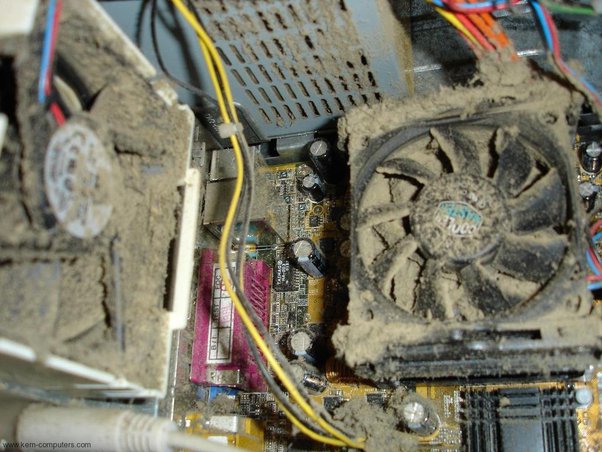
Why Is 60 Degrees Celsius Considered Normal?
Designed for High Temperatures:
GPUs are built to handle high temperatures. Most modern GPUs can safely operate up to 85-95 degrees Celsius, so 60 degrees Celsius is well within this safe range.
Typical Load Temperature:
When the GPU is doing demanding tasks, like gaming or video editing, it naturally gets warmer. 60 degrees Celsius is a common and safe temperature for a GPU under these conditions.
Efficient Cooling:
At 60 degrees Celsius, your GPU’s cooling system is working effectively to manage the heat produced during heavy use. It indicates that the cooling solution (fans, heatsinks) is doing its job.
Temperature Fluctuations:
60 degrees Celsius is a stable temperature that your GPU can maintain during extended use. It shows that your GPU isn’t overheating or running too cool.
Performance and Longevity:
Operating at 60 degrees Celsius ensures that the GPU performs well and doesn’t suffer from excessive heat stress, which helps extend the life of your graphics card.
Can A GPU Work At 60 Degrees Celsius All The Time?
Yes, a GPU can work at 60 degrees Celsius all the time without any issues. This temperature is well within the safe operating range for most GPUs, which are designed to handle much higher temperatures.
Running at 60 degrees Celsius means your GPU is effectively cooled and performing efficiently, so it won’t experience any damage or reduced lifespan from operating continuously at this temperature.
Read More: Gpu Only Works In Second Slot – Isolate The Problem!
How Can You Maintain A Safe GPU Temperature?
- Designed Temperature Range: GPUs are built to handle temperatures up to 85-95 degrees Celsius, so 60 degrees is well within their safe operating range.
- Efficient Cooling: At 60 degrees Celsius, the GPU’s cooling system, including fans and heatsinks, is working effectively to manage heat.
- Optimal Performance: Operating at 60 degrees Celsius allows the GPU to perform optimally without thermal throttling, which occurs when the GPU slows down to prevent overheating.
- System Stability: Maintaining a temperature around 60 degrees Celsius ensures system stability, preventing crashes or glitches during intensive tasks.
- Longevity: Consistently running at 60 degrees Celsius helps prolong the GPU’s lifespan by minimizing thermal stress on its components.
What Modern Cooling Technologies Help Keep GPUs Cool?
Modern GPUs use several advanced cooling technologies to stay cool. Dual and triple fan designs increase airflow and improve heat dissipation. Vapor chamber cooling spreads heat more evenly across the GPU, enhancing cooling efficiency.

Heat pipes transfer heat away from hot spots quickly. Some GPUs also have a zero RPM mode, where fans stop spinning when the GPU is cool to reduce noise and wear.
Do External Factors Like Humidity Affect GPU Temperatures At 60 Degrees Celsius?
External factors like humidity generally don’t have a significant impact on GPU temperatures. However, high humidity can potentially affect the overall cooling efficiency of your system by slightly reducing heat dissipation. But for the most part, humidity alone won’t cause your GPU to overheat or affect its temperature if it’s around 60 degrees Celsius.
Can Using Multiple Monitors Increase My GPU Temperature To 60 Degrees Celsius?
Yes, using multiple monitors can increase your GPU temperature. Running multiple displays requires more processing power from your GPU, which can lead to higher temperatures. This increase is usually minor, and a well-cooled GPU should handle the extra load without exceeding safe temperature limits like 60 degrees Celsius.
Also Read: Runtimeerror: Gpu Is Required To Quantize Or Run Quantize Model. – Read Our Guide!
FAQs:
1. Does Room Temperature Affect GPU Temperature?
Yes, higher room temperatures can make your GPU run a bit hotter, but 60°C is still normal and safe.
2. Can High GPU Temperatures Damage My Computer?
Yes, consistently high GPU temperatures can damage your computer over time, but 60°C is a safe temperature.
3. Should I Worry If My GPU Reaches 60 Degrees Celsius?
No, you don’t need to worry. 60 degrees Celsius is a normal and safe temperature for a GPU under load.
4. Does Overclocking Increase GPU Temperature?
Yes, overclocking makes your GPU work harder and generates more heat, which can increase temperatures.
5. What Cooling Solutions Are Best For Keeping My GPU Cool?
Good cooling solutions include extra case fans, aftermarket GPU coolers, and proper airflow in your PC case.
6. Can I Lower My GPU Temperature Without Extra Cooling?
Yes, you can clean your PC, improve airflow, and check for dust to help lower temperatures without adding extra cooling.
7. Is It Safe To Use My Computer If The GPU Is At 60 Degrees Celsius?
Yes, it is safe. 60 degrees Celsius is a normal operating temperature for a GPU during heavy tasks.
8. Will Adding More RAM Affect My GPU Temperature At 60 Degrees Celsius?
No, adding more RAM does not affect GPU temperature. GPU temperature is influenced by workload and cooling.
9. How Long Can My GPU Sustain Temperatures Around 60 Degrees Celsius Before It Starts To Degrade?
Your GPU can handle 60 degrees Celsius for a long time without degrading. It’s a safe temperature for both performance and lifespan.
10. Should I Adjust Fan Speeds To Keep My GPU At 60 Degrees Celsius?
If your GPU is consistently at 60 degrees Celsius, you usually don’t need to adjust fan speeds, as this temperature is normal.
Conclusion:
Is 60 degrees Celsius hot for a GPU? No, 60 degrees Celsius is not hot for a GPU. It is a normal and safe temperature, even when your GPU is working hard during tasks like gaming or rendering. GPUs are designed to operate safely at higher temperatures, often up to 85-95 degrees Celsius. So, 60°C indicates that your GPU is performing well and staying within its safe temperature range.
Related Posts:
- Can You Use Amd Gpu With Intel Cpu – Enjoy The Performance!
- Is Beamng Cpu Or Gpu Intensive – Conquer Both!
- Cuda Setup Failed Despite Gpu Being Available – Explore For All Details!
- Runtimeerror: No Gpu Found. A Gpu Is Needed For Quantization. – Here’s How to Fix It!

James George is a GPU expert with 5 years of experience in GPU repair. On Techy Cores, he shares practical tips, guides, and troubleshooting advice to help you keep your GPU in top shape. Whether you’re a beginner or a seasoned tech enthusiast, James’s expertise will help you understand and fix your GPU issues easily.

